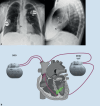[History of cardiac resynchronization therapy : 30 years of electrotherapeutic management for heart failure]
- PMID: 38424340
- PMCID: PMC10923969
- DOI: 10.1007/s00399-024-01004-2
[History of cardiac resynchronization therapy : 30 years of electrotherapeutic management for heart failure]
Abstract
The first permanent biventricular pacing system was implanted more than 30 years ago. In this article, the historical development of cardiac resynchronization therapy (CRT), starting with the pathophysiological concept, followed by the initial "proof of concept" studies and finally the large prospective-randomized studies that led to the implementation of CRT in heart failure guidelines, is outlined. Since the establishment of CRT, both an expansion of indications, e.g., for patients with mild heart failure and atrial fibrillation, but also the return to patients with broad QRS complex and left bundle branch block who benefit most of CRT has evolved. New techniques such as conduction system pacing will have major influence on pacemaker therapy in heart failure, both as an alternative or adjunct to CRT.
Vor mehr als 30 Jahren erfolgte die erste Implantation eines permanenten, biventrikulären Herzschrittmachersystems bei einem Patienten mit Herzinsuffizienz und ventrikulärer Leitungsstörung. In diesem Artikel soll die historische Entwicklung der kardialen Resynchronisationstherapie (CRT) vom pathophysiologischen Konzept über die ersten Proof of concept-Studien bis hin zu den großen randomisierten Studien, die dann zum Einzug der CRT in die Leitlinien zur Behandlung der Herzinsuffizienz geführt haben, dargestellt werden. Auch nach der Etablierung der CRT kam es zum einen zu einer Ausweitung der Indikationen z. B. auf Patienten mit milder Herzinsuffizienz oder Vorhofflimmern, aber auch zur Rückbesinnung auf die Patienten mit breiterem QRS-Komplex und Linksschenkelblock, die am meisten profitieren. Neue Techniken wie das Conduction-System-Pacing werden die Schrittmachertherapie bei Herzinsuffizienz verändern, als Alternative oder Ergänzung zur CRT.
Keywords: Cardiac resynchronization therapy; Conduction System Pacing; Heart failure; Left bundle branch block; Pacemaker.
© 2024. The Author(s).
Similar articles
-
His-Optimized and Left Bundle Branch-Optimized Cardiac Resynchronization Therapy: In Control of Fusion Pacing.Card Electrophysiol Clin. 2022 Jun;14(2):311-321. doi: 10.1016/j.ccep.2021.12.006. Epub 2022 May 23. Card Electrophysiol Clin. 2022. PMID: 35715088 Review.
-
On-treatment comparison between corrective His bundle pacing and biventricular pacing for cardiac resynchronization: A secondary analysis of the His-SYNC Pilot Trial.Heart Rhythm. 2019 Dec;16(12):1797-1807. doi: 10.1016/j.hrthm.2019.05.009. Epub 2019 May 13. Heart Rhythm. 2019. PMID: 31096064 Clinical Trial.
-
Permanent His bundle pacing to replace biventricular pacing for cardiac resynchronization therapy.Med Hypotheses. 2017 Nov;109:77-79. doi: 10.1016/j.mehy.2017.09.026. Epub 2017 Sep 28. Med Hypotheses. 2017. PMID: 29150300
-
Randomized Trial of Left Bundle Branch vs Biventricular Pacing for Cardiac Resynchronization Therapy.J Am Coll Cardiol. 2022 Sep 27;80(13):1205-1216. doi: 10.1016/j.jacc.2022.07.019. J Am Coll Cardiol. 2022. PMID: 36137670 Clinical Trial.
-
Left bundle branch pacing versus biventricular pacing for cardiac resynchronization therapy: A systematic review and meta-analysis.Pacing Clin Electrophysiol. 2023 May;46(5):432-439. doi: 10.1111/pace.14700. Epub 2023 Apr 10. Pacing Clin Electrophysiol. 2023. PMID: 37036831
References
-
- Wiggers CJ. The Muscular Reactions Of The mammalian Ventricles To Artificial Surface stimuli. Am J Physiol Content. 1925;73:346–378. doi: 10.1152/ajplegacy.1925.73.2.346. - DOI
-
- Lösse B, Kuhn H, Krönert H, et al. Hemodynamic and radiocardiographic exercise studies in patients with complete left bundle branch block and normal-sized heart (author’s transl) Z Kardiol. 1979;68:304–312. - PubMed
-
- Curtius JM, Nowitzki G, Köhler E, et al. Left bundle-branch block: inferences from ventricular septal motion in the echocardiogram concerning left ventricular function. Z Kardiol. 1983;72:635–641. - PubMed
Publication types
MeSH terms
LinkOut - more resources
Full Text Sources
Medical
Research Materials



